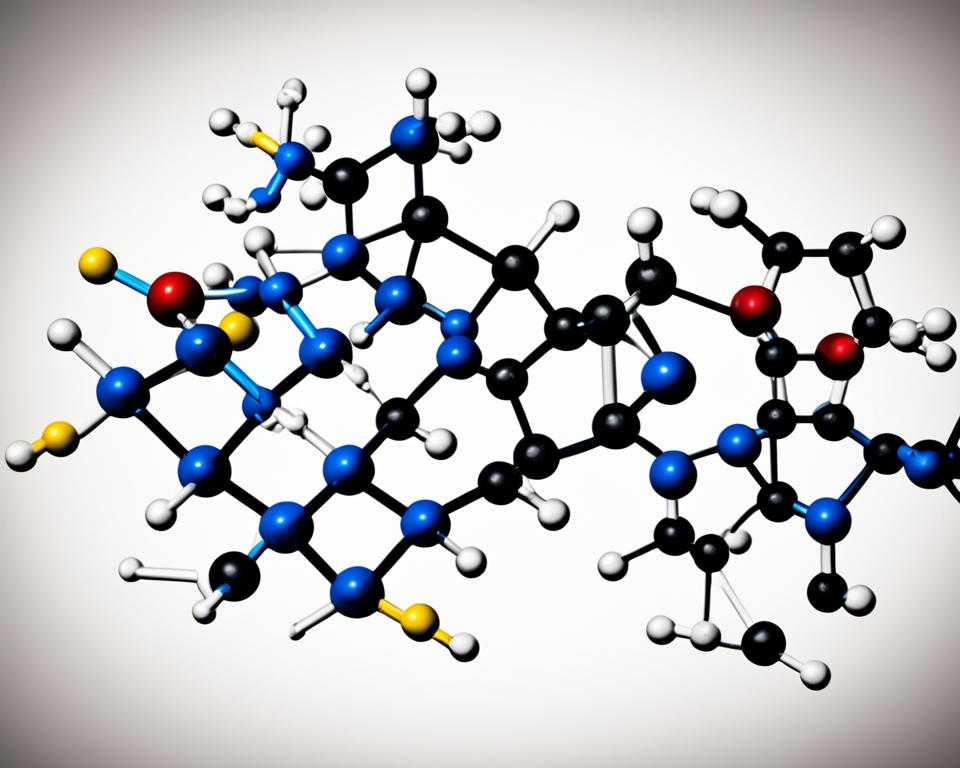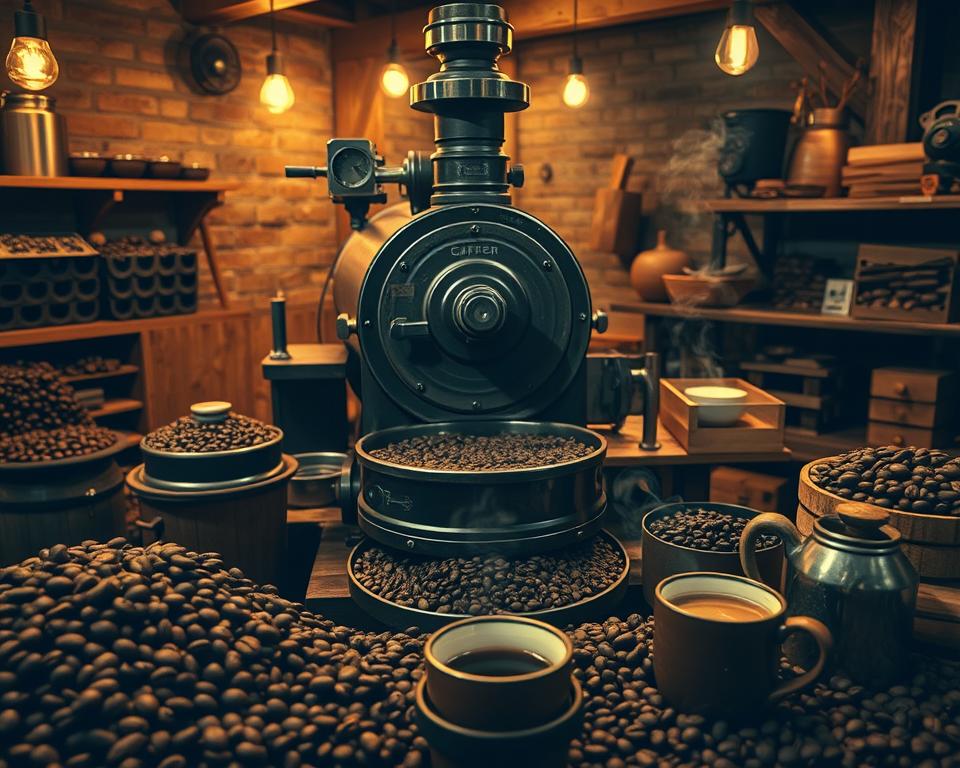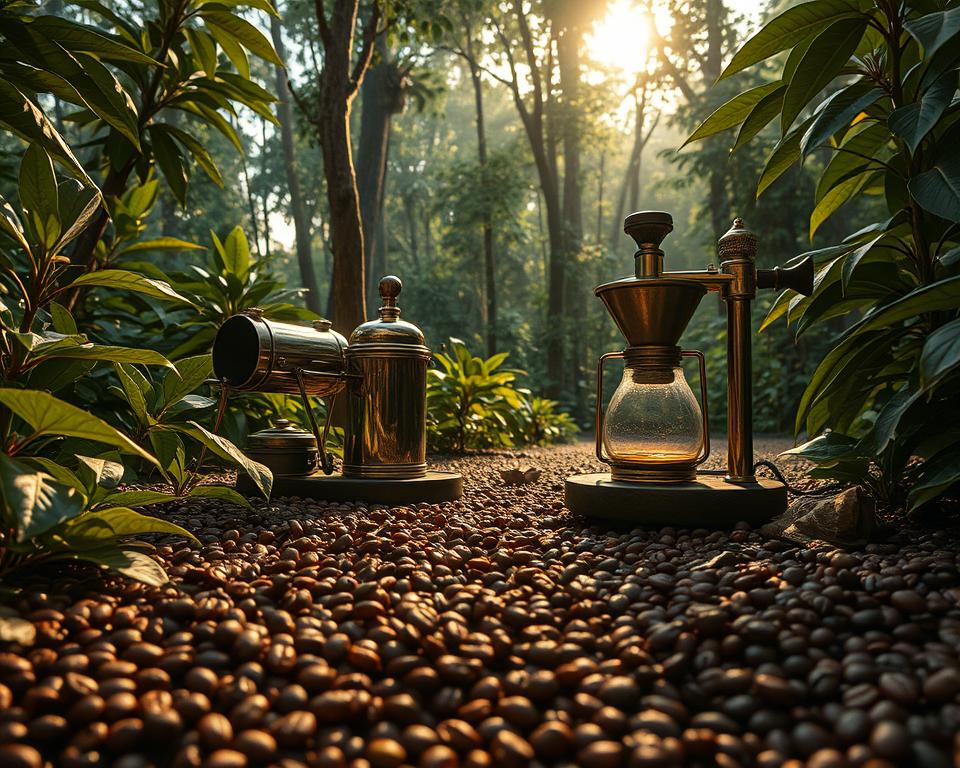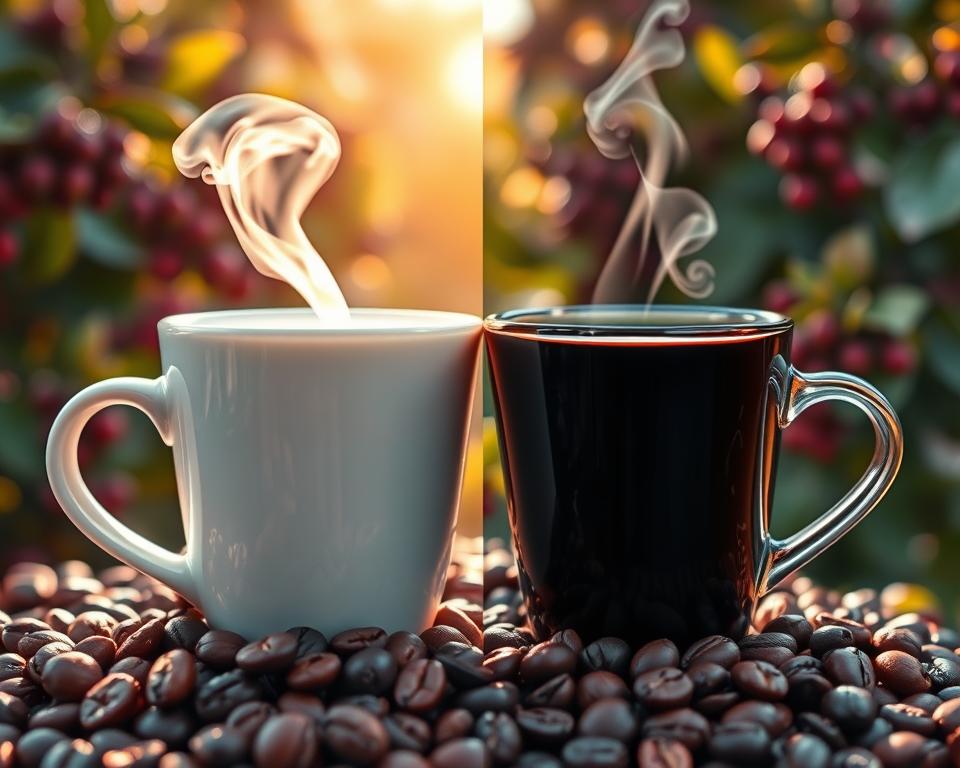Did you know that, despite its strong flavour, dark roast coffee doesn’t necessarily contain more caffeine than lighter roasts?
Many people choose dark-roasted coffee for its bold and smooth flavour, assuming it packs a higher caffeine kick. But there’s a common misconception about caffeine levels in dark roast.
In essence, the relationship between coffee roast levels and caffeine content isn’t as straightforward as it seems.
Various factors, such as roasting time and temperature, significantly affect the caffeine content of coffee. As coffee beans roast, they undergo chemical changes that alter their caffeine concentration.
Understanding these changes is crucial for appreciating the true caffeine content of dark-roasted coffee.
This in-depth look will explore the reality of dark roast coffee caffeine levels, revealing whether your favourite dark brew is as potent as you think.
Introduction to Dark Roast Coffee
Let’s dive into what makes dark roast coffee special. It’s all about the coffee-roasting process. This process gives dark roast its bold flavour and distinct appearance.
When coffee beans are roasted longer and at higher temperatures, they transform into the shiny black beans we associate with dark-roasted coffee.
The history of coffee roasting shows how dark roasts became popular. Back in the day, coffee lovers experimented with roasting techniques to perfect the flavour profiles they desired.
Over time, the deep, rich flavours of dark roast won many hearts and taste buds.
Speaking of flavour profiles, dark roast coffee is known for its pronounced bitterness and full-bodied taste. The beans glisten with an oily surface, a sign of the intense roasting.
This roasting level brings out smoky and slightly burnt notes, appealing to those who enjoy a strong, robust cup.
So, what types of beans are used for dark roasts? Typically, these are Arabica and Robusta beans. Arabica beans are preferred for their smooth flavour and aromatic qualities.
Robusta beans, on the other hand, offer a higher caffeine content and a more intense flavor. Often, a blend of Arabica and Robusta is used to create a balanced and flavorful dark roast.

Next time you sip a cup of dark roast coffee, remember the intricate coffee roasting process that gives it such unique flavor profiles. Whether it’s pure Arabica or a mix with Robusta beans, dark roast coffee offers a rich and satisfying experience.
Understanding Caffeine
Caffeine is more than just a pleasant morning kick; it’s a fascinating compound with intricate chemical properties of caffeine. As we journey through the world of coffee, knowing about caffeine’s role in our beloved brew is essential.
What Is Caffeine?
At its core, caffeine belongs to a class of compounds known as xanthines, which naturally occur in coffee beans, tea leaves, and even cacao pods.
Due to its stimulant effects, caffeine is hailed for its ability to keep us awake and alert. This bitter substance works its magic primarily by blocking adenosine receptors in the brain, a process that helps ward off drowsiness.
How Does Caffeine Work?
When we sip that daily cup of coffee, the caffeine quickly absorbs into our blood and heads straight for the central nervous system. It creates a stimulating reaction by increasing the levels of neurotransmitters, like dopamine and norepinephrine, that enhance focus and mood. Notably, these stimulant effects can help improve reaction time, vigilance, and even exercise performance.

But there’s more to caffeine than just the kick. The health benefits of moderate caffeine consumption are well documented. It may protect against certain neurodegenerative diseases, like Parkinson’s and Alzheimer’s.
However, like anything, moderation is key—too much caffeine can lead to jitteriness, insomnia, or an increased heart rate.
Understanding these chemical properties of caffeine enriches our appreciation of coffee. After all, it’s the delicate balance of these elements that makes each cup not just a beverage but a little marvel of chemistry and well-being.
How Dark Roasting Affects Caffeine Levels
Many wonder if roast intensity influences caffeine content. It’s a common belief that darker roasts, with their bold flavour, pack more caffeine. But is this true?
The truth lies in the coffee’s chemistry. roasting temperature and duration play a big role. While roasting a batch, beans undergo chemical changes.
Higher roasting temperatures can lead to slight caffeine loss, but the change is minimal.
- Darker roasts reach higher temperatures during roasting.
- This high roasting temperature causes some chemical changes within the beans.
- Caffeine stability is quite resilient, despite the high roasting intensity.
An in-depth analysis reveals that while there’s a shift in certain compounds within the beans, caffeine tends to remain stable. Studies comparing caffeine content at different roast levels show minor variations. Often, the difference is too small to notice during consumption.
How Much Caffeine Is in Dark Roast Coffee?
When it comes to understanding the caffeine measurements in dark roast coffee, many factors come into play. Generally, the caffeine measurements for a typical dark roast range between 50 and 90 milligrammes per 8-ounce cup.
It’s essential to look at the average caffeine content across various brands for a more precise idea.
One thing I’ve noticed is the difference in caffeine content between espresso and brewed coffee. Typically, espresso has around 63 milligrammes of caffeine per shot, which might seem higher, but brewed coffee usually has more overall due to the larger serving size.
The average caffeine content in a standard cup of brewed dark roast can vary significantly based on several factors.
These variations are often due to the size and density changes of the beans during the roasting process. Darker roasts tend to be less dense, caused by longer roasting times, which means measuring by volume may give you slightly less caffeine per scoop.
Understanding the caffeine content on coffee packaging can make a big difference for those managing their intake. These labels often provide caffeine measurements per serving, helping you make an informed decision about whether you prefer espresso to brewed coffee.
So next time you’re evaluating your coffee choice, keep these factors in mind to better understand your perfect cup.
Comparing Light Roast vs. Dark Roast Caffeine Content
When exploring the roasting spectrum of coffee, it’s interesting to see how light roasts differ from dark roasts not just in flavor but in caffeine content as well.
What’s Different About Light Roasts?
Light roast coffees are typically roasted for a shorter amount of time, which preserves the bean’s original coffee profiles, including higher acidity and a more complex flavor.
They generally exhibit a lighter body compared to dark roasts.
Caffeine Levels: Light vs. Dark
Contrary to popular belief, dark roasts do not necessarily contain more caffeine than light roasts. In fact, a caffeine comparison of the two reveals that light roasts often have a higher concentration of caffeine due to less exposure to heat.
The longer roasting process for dark roasts reduces some of the caffeine content.
Looking at the entire roasting spectrum, we find that each level of roast offers unique coffee profiles. While many might think dark roasts pack a caffeine punch, light roasts surprisingly hold their own in the caffeine comparison.
Understanding these differences allows coffee lovers to make informed choices based on both flavor and desired caffeine intake.
Factors That Influence Caffeine The content contains details about the varietal differences in caffeine concentration between popular coffee species.
Understanding what influences the caffeine content of coffee can be a bit complex. Factors like the type of bean, brewing method, and even grind size all play a significant role in the final caffeine concentration.
The specific variety of coffee bean affects caffeine levels. Arabica beans, for instance, generally have less caffeine than Robusta beans, which are sometimes used in dark roasts. It might surprise you to learn that bean roasting has more to do with flavour and aroma than actual caffeine content.
The brewing method also makes a huge difference. A standard cup of drip coffee typically contains more caffeine than a shot of espresso, despite what you might expect. This is because the brewing process extracts caffeine over a longer period, leading to a higher caffeine content per cup.
Lastly, the grind size can impact caffeine extraction. A finer grind exposes more surface area to water, which can result in a stronger brew with higher caffeine levels. On the other hand, a coarser grind might deliver a mellower and less caffeinated coffee.
Isn’t it fascinating how these elements come together to influence what ends up in your cup? Understanding these factors can help you better control your caffeine intake and enjoy your coffee just the way you like it.
My Personal Experience with Dark Roast Coffee
Embarking on my personal coffee journey, I began with light roasts. They woke me up gently, along with a hint of bright acidity. However, curiosity led me to explore the rich world of dark roast coffee, and boy, was it an adventure!
I found my brew preferences shifting over time. The bold, full-bodied flavour of dark roasts felt like a comforting hug in a cup. But with this new love came lessons about my caffeine sensitivity. While the robust taste was delightful, I had to be mindful of how its caffeine content affected my energy levels.
Switching from a lighter to a darker roast had its nuances. It changed my daily routines and even influenced my mood and productivity. I noticed how my morning cup set the tone for my day, sometimes making it brighter or, on rare occasions, a tad too jittery.
To those navigating their own personal coffee journey, I say, experiment boldly! Try different roasts and observe how your brew preferences evolve. Pay attention to how each variation impacts your body, especially if you have caffeine sensitivities.
Who knows? You might discover your perfect cup of coffee, just like I did. Happy sipping!
How Does the Caffeine Content of Dark-Roast Coffee Compare to Cafe Bustelo Espresso?
Dark-roast coffee often surprises coffee lovers with its robust flavor and lower acidity. However, it typically has less caffeine than lighter roasts. When comparing the caffeine content in cafe bustelo, espresso stands out for its concentrated caffeine levels, making it an energizing choice for those seeking a bold kick.
Conclusion
After exploring the intricacies of caffeine content in dark roast coffee, I hope you now feel more confident in making smart coffee choices. Understanding how roasting affects caffeine levels allows us to make informed caffeine consumption decisions that align with our individual needs and preferences. I
It’s fascinating to see how different roasting techniques and bean types contribute to the final caffeine content in our cup.
Our journey through the world of coffee shouldn’t stop here. Whether you’re a fan of dark roasts or prefer a lighter brew, there’s always something new to discover.
Just a friendly reminder to make your coffee experience your own. Let your unique taste and lifestyle shape the perfect cup of coffee for you. So, I encourage you to experiment with various roasts and brewing methods to find what truly enhances your coffee moments.
Armed with the knowledge from this article, you can apply these insights to your daily coffee rituals. This empowers you to tailor your coffee habits, ensuring a more enjoyable and tailored experience.
Here’s to many more delightful and caffeine-smart coffee adventures ahead!
FAQ
How much caffeine is in dark-roasted coffee?
Dark-roasted coffee typically contains slightly less caffeine than light-roasted coffee because caffeine is lost during the roasting process. However, the difference is minimal, and many people don’t notice a significant change in their caffeine intake.
Does dark roast coffee have more caffeine than light roast coffee?
Contrary to popular belief, dark roast coffee usually has less caffeine than light roast coffee. The longer roasting time and higher temperatures break down some of the caffeine, though the difference is often negligible for the average coffee drinker.
What makes dark-roasted coffee taste different from light-roasted coffee?
Dark-roasted coffee is roasted longer and at higher temperatures, which results in a bold, smoky flavor. It also tends to have a lower acidity compared to light roast, which is lighter and has more pronounced fruity and floral notes.
Are the caffeine levels in Arabica and Robusta beans different?
Yes, Robusta beans generally contain higher caffeine levels than Arabica beans. This is why blends, including Robusta, are often used for dark roast coffee to boost the caffeine content and add a more robust flavour.
What factors influence the caffeine content of my coffee?
Several factors influence the caffeine content in your coffee, including the type of bean (Arabica or Robusta), roasting time and temperature, grind size, brewing method, and how much coffee you use.
How does roasting time affect caffeine stability in coffee beans?
Roasting time affects the chemical composition of coffee beans, including caffeine stability. While caffeine is relatively stable, longer roasting times can slightly decrease its concentration due to the heat breaking down some of the caffeine molecules.
Can I tell the caffeine content by looking at the coffee beans?
No, it’s not possible to determine the exact caffeine content just by looking at the coffee beans. However, darker coffee beans typically indicate a longer roasting process, which usually means slightly less caffeine compared to lighter roasts.
Does brewed coffee have more caffeine than espresso?
Generally, brewed coffee has more caffeine per serving than a single shot of espresso because the serving size is larger. However, espresso has a higher concentration of caffeine per ounce.
What’s the difference between the flavour profiles of light and dark roast coffee?
Light-roasted coffee tends to have more acidic, fruity, and floral flavours, while dark-roasted coffee has a bolder, smokier, and sometimes bitter taste. The flavour profile changes due to the chemical reactions during the roasting process.
How can I control my caffeine intake?
You can control your caffeine intake by choosing the type of coffee bean, adjusting the coffee-to-water ratio, selecting your preferred roast level, and considering your brewing method. Reading the labels for caffeine content can also help manage your intake.




